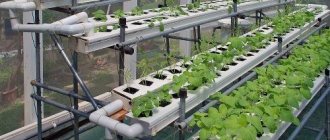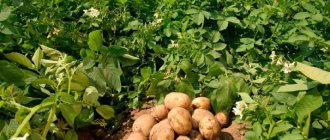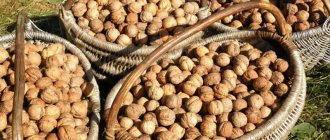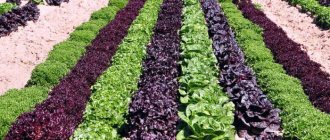Attachments: from 1,110,000 rubles
Payback: from 3 years
Why will farming always be in demand, and in a few years will become one of the highest paying niches? Today, few people think about where the vegetables and fruits on the shelves come from. Everyone is concerned about something else: working for results and success. Over the past 30 years, many have stopped gardening, because it is easier to buy vegetables in the store than to grow them all summer. With the number of farmers decreasing, demand is growing, and it is necessary to supply the market. One of the products that is an excellent option for starting a farming career is cabbage. How to make money on it?
Where to begin?
White and blue cabbage are grown in our country on a huge scale. Due to the large production capacity, the cost per unit of product is low, so it is very difficult to maintain healthy competition. Other types of vegetables should be considered to occupy their profitable niche at more modest volumes.
To begin with, you should consider the following questions:
- For a specific region, determine the type with the greatest profitability;
- Study the features of agricultural technology of the selected vegetable;
- Establish the cultivation of organic crops without the use of chemicals, as is done in large businesses;
- Find ways to sell products, arrange direct supplies of vegetables. If you refuse intermediary services, the final cost per unit of goods will be much lower. Among the likely consumers, consider retailers, individuals, restaurants and other food service establishments;
- Rent a plot of land. Depending on the registration of activity, requirements are established for the minimum area of land; for individual entrepreneurs, at least 1 hectare is required. The main characteristics of the site are the selection of well-fertilized, non-acidic, heavy and medium loamy soil, with a low-lying location for more moisture, the presence of convenient access roads, and close location to the main place of sale.
Consider renting a vegetable storage facility for the harvested crop.
All issues are easily reflected when drawing up a business plan, which takes into account the following data:
- Taxes;
- Cost of fertilizers, planting material, agrotechnical measures;
- Salary of hired labor;
- Fare;
- Rent amount for land and vegetable storage.
Based on the calculation results, the expected profit from sales should be displayed. When constructing greenhouses, additional costs will be required, but an earlier release of the product to the shelves will significantly increase its price.
Enterprise registration
The main condition for registration as a business entity is the availability of at least 1 hectare of land for business. After successfully acquiring a plot of land for ownership or lease, it is necessary to develop business planning for registering a peasant farm.
IMPORTANT: If the area allocated for farming is less than 1 hectare, then you do not need to register, nor do you need to pay tax to the state.
Tax system
For a modern producer of cabbage of any variety, there are three types of taxation:
- General system (if the company is large and its annual turnover exceeds several million rubles);
- simplified tax system for an individual entrepreneur or LLC;
- Unified agricultural tax for peasant farm enterprises.
The individual characteristics of a particular business will best suggest the most profitable tax payment system.
Required documents
To open a vegetable growing enterprise, you will need to provide the following package of documents:
- Signed employment contracts with hired workers and permanent staff;
- A certificate from the bank about opening an account, which should be registered with the Federal Tax Service no later than 3 calendar days;
- Agreements concluded with counterparties;
- A standard set of documents for a legal entity or individual (passport of a citizen of the country, IIN, insurance, etc.).
IMPORTANT: It is imperative that the lease agreement be concluded correctly, as specified in the law. Additional permits from the fire inspectorate and SES will also be required.
OKVED
The legislation provides for registration of business entities only as LLC or individual entrepreneur. When registering, OKPD 01.13.1 is indicated, which allows you to grow “Green or salad crops.”
Cabbage growing business
Starting capital – from 500 thousand rubles.
Cabbage is one of the most common types of vegetables in our country. Humanity mastered its cultivation many centuries ago; a significant part of our dishes includes this ingredient. Cabbage is grown both by ordinary villagers for personal use and by large agricultural complexes for mass sale. And this is partly determined by the very high demand for this product - annual sales only confirm this. Therefore, it is not so difficult for entrepreneurs to find sales points for grown cabbage. All of the above has a positive effect on the entry threshold for aspiring entrepreneurs.
Content
- Registration moments
- Territory
- Varieties of cabbage
- Cabbage
- Brussels sprouts
- Broccoli
- Results
- Video: Business plan for growing cabbage
Registration moments
According to the law, it is determined that a farm must own at least 1 hectare of land - smaller areas of land are not subject to registration as an object of entrepreneurial activity and are considered a personal subsidiary plot. In the second case, there is no need to report taxes, and the crops grown on such a plot are mainly intended for personal use (some sell the grown vegetables, fruits and berries in markets or on roadsides). But a farm engaged in cultivation on an industrial scale must already be registered as a peasant farm. Although no one forbids you to register as a legal entity or individual entrepreneur. According to OKPD 2 (All-Russian Classifier of Products by Type of Economic Activities), code No. 01.13.1 “Vegetable, salad or green crops” is used.
Territory
Once the registration aspects have been resolved, you should move on to finding land to plant. Almost any soil is suitable for ordinary garden cabbage (except for soil with a high content of sand and gravel). Cabbage is a moisture-loving crop, so it is better to provide it with soil that retains moisture well. The acidity should be moderate or slightly acidic so as not to provoke some crop diseases. Almost all varieties of cabbage grow well even in soil with a high content of alkaline compounds.
Do not forget that any cabbage grows poorly in soil in which cabbage, turnip, mustard and similar crops were previously sown. This often leads to a number of diseases, and they also become a more “tasty” target for pests.
Taking into account all of the above, it is necessary to purchase about 5 hectares of land for a significant harvest. Please note that the most profitable enterprise with minimal risks is your own multi-faceted multi-industry farming enterprise. This means that it is worth sowing not only cabbage - after a few years it is better to change the location for sowing, and use the vacated area for sowing some other crop.
If space allows, you can start growing not only vegetables, but also fruit trees, cereals, or even organize your own apiary. You can also try your hand at animal husbandry - you can use the grown crops to create feed. So, the ideal option is to grow cabbage and other crops together.
The average cost of annual rental of 1 hectare of land is 3.5-5 thousand rubles. (region and proximity to cities have a big influence). In total, 5 hectares of land will cost you 10 thousand rubles.
Varieties of cabbage
The Brassicaceae family includes a wide range of different plants (most of them don't even look like cabbage, but they are widely used in many industries). Of course, the most common of them is cabbage and its varieties: Brussels sprouts, broccoli and others. Widely used by humans as food and feed crops. You will not find oilseeds in this family - the seed is too small with a minimal percentage of fat content.
Also used in the medical industry (in particular, for the manufacture of various drugs), pharmaceuticals. Used to prevent a number of diseases. Humanity has been growing cabbage for centuries, for this reason you can find a huge number of varieties specially bred for specific needs, weather conditions and soil. When growing these crops, both classical (tractors, plows and walk-behind tractors) and special equipment - combines - are used. You can buy it, or you can rent it.
Cabbage
The most common variety in our country. Classified as Cabbage. It is the easiest to grow and sell. A 2-year-old plant that looks like a bush with wide leaves. Only cabbage leaves and heads of cabbage have value.
Cabbage is very rarely sown in pre-prepared soil - most often, seedlings are harvested 1-2 months before above-zero temperatures are established. You can get them from grains, or you can buy them at a specialty store. For 1 hectare you will need about 6 kg of seeds, the cost of 1 kg of seeds is 100-120 rubles.
Seedlings are germinated either in greenhouses or at home. Before planting crops, leave them for a short time in a place with slightly sub-zero temperatures - the so-called “acclimatization”. After preparation, they are transferred to previously prepared soil (which has already been loosened, moistened and fertilized). A mixture of organics and inorganics is perfect for fertilizer.
In the first week (in some cases this is done more often), the crop must be watered abundantly. Then the frequency of watering can be reduced, but it should be left at a high level.
From 5 hectares of land you can harvest about 125 tons of cabbage. The average cost for 1 kg is 8 rubles. Total, we get 8 rubles/kg * 125000 kg = 1 million rubles. At the same time, about 25 tons per 1 hectare is the yield of early varieties of cabbage; mid- and late-ripening varieties have a standard indicator of 50 tons. Naturally, their cost will be higher.
In parallel with growing cabbage, you can start fermenting it. Note that in addition to white cabbage, you can grow a large number of other varieties, which are gradually gaining popularity, and some of them are considered by buyers as a separate crop that has nothing in common with ordinary cabbage.
A striking example of this is cauliflower. It is often used as a dietary product. Its inflorescences are used for food; Moreover, they are fried, stewed, and are a component of vegetable mixtures. Cauliflower differs from white cabbage in having higher requirements for soil composition. Its seedlings require special conditions; the growing season is longer. At other points, the cultivation process is almost the same.
Brussels sprouts
Many consider it a separate vegetable. But from a botanical point of view, it is a variety of the Cabbage family. The cultivation technique is almost no different from growing ordinary cabbage. Brussels sprouts are grown only by seedlings. The average cost of 1 kg of Brussels sprouts is 300-400 rubles, the cost of seed material for seedlings is 6.5-8 thousand rubles. It tolerates dry conditions a little better (due to its more powerful rhizome), although it also loves moisture. This variety has increased resistance to temperature changes. The growing season is mid-to-late November, so sometimes the crop is transferred to greenhouse conditions for ripening.
A distinctive feature of white cabbage from Brussels sprouts is its size. The first grows with 1 head of cabbage, while the second consists of a large number of small heads of cabbage. Productivity – 22 tons per 1 ha. Accordingly, the yield for 5 hectares is 110 tons. Moreover, its cost is an order of magnitude higher than that of white cabbage - about 75-100 rubles/1 kg. Estimated profit – 8 million rubles. with a good harvest with a minimum percentage of defects.
Broccoli
A distinctive feature of broccoli from cabbage is that it is a 1-year-old crop (regular and Brussels sprouts are 2-year-old plants). One of the disadvantages is the very small frame for harvesting. This is because if you overexpose broccoli, the flower will begin to bloom, and it gives it a not entirely marketable appearance for a food crop. It also loses its beneficial properties relatively quickly. It is also much more difficult to store - it will be necessary to purchase powerful freezing units in case of long-term storage or to sell the harvest as quickly as possible.
The shelf life of collected inflorescences is no more than 2 weeks. For this reason, it is necessary to organize distribution channels in advance (preferably several months before harvest). Most experienced vegetable growers use the following method of selling their crops:
- The client independently comes to your lands;
- He also cuts a certain number of plants. Naturally, with the use of appropriate equipment, without using the manual labor of the consumer.
To maintain this unstable condition of broccoli, additional irrigation can be used in case of particularly dry weather conditions. In terms of yield, broccoli is almost identical to Brussels sprouts. The only difference is that broccoli has a higher yield - about 25 tons per 1 ha. However, growing broccoli will be a little more expensive.
Results
The Brassicaceae (or Cruciferous) family has been used by mankind for many centuries and is used in various industries. Cabbage and its varieties are widely used as a food crop as everyday and dietary components in many dishes. Even despite the huge difference in the cost of white cabbage, Brussels sprouts and broccoli, it can be noted that the first variety is the easiest to grow. Income is also high, since the demand for it is huge.
Nowadays, types of cabbage such as broccoli and Brussels sprouts are gaining popularity. The reason for this is the massive transition of the population to a healthy diet, and these varieties are an excellent dietary product.
Business plan for growing cabbage
Organization of cultivation
For any type of agricultural activity, it will be necessary to purchase, for rent or ownership, a plot of land suitable for cultivating cabbage. The most important thing for a vegetable is its presentation, since it is this quality that allows perishable products to be sold faster without leaving them waiting for a long time.
For this purpose, a regular biennial change of planting location is recommended. It is recommended to simultaneously grow the same areas of other crops to maintain soil fertility. Full cultivation of cabbage requires good lighting.
The distance from sales points determines the cost of transporting products. This needs to be included in the business planning project. On the one hand, you can rent land located far from the city limits and at the same time spend money on fuel and transport, but save on the price of rent; on the other hand, a close location allows you to save on gasoline, but is compensated for by a higher rent.
Greenhouse cultivation involves the construction of special structures, the cost of which should be taken into account in the business plan. In addition, to organize year-round cultivation, it will be necessary to install an irrigation, lighting and heating system in the greenhouses. This will add to the cost of constructing the structure, and when used, heating and electricity bills will be added.
The most popular varieties and cultivation technology
The following types of salad are in greatest demand among the population:
- "Romano";
- "Iceberg";
- "Frisse";
- "Radicchio."
The cost of one kilogram of salad ranges from 30 to 55 rubles.
It is necessary to choose a variety for planting carefully, because many of them are suitable for cultivation only during a certain period.
IMPORTANT! Lettuce is considered a cold climate crop that loves light and moisture. Lack of light, temperatures above 25 degrees and low air humidity lead to the fact that many varieties begin to bloom, the leaves become bitter and become less juicy.
For growing lettuce, the flow hydroponics method is considered the most suitable. This method allows you to convey to customers the full nutritional value of the product.
Using hydroponic lettuce growing as a business is very profitable. At the same time, cultural growth accelerates, and accordingly, income increases. This method is very popular among farmers.
It is better to use peat substrate as a substrate. It is carefully sifted and fertilized. Fertilized and limed peat will be the key to growing. Before treated seeds are sown in cassettes, the peat must be thoroughly moistened. The seeds are covered with a very thin layer of substrate.
Germinated seedlings are transferred in cassettes to the tables of the seedling department. Additional lighting, watering and nutrients are provided for it. After a seven-day stay in this compartment, the pots of seedlings are transferred to cultivation trenches.
Commercial maturity of lettuce occurs after 35 days for leaf varieties, and after 40 days for cabbage varieties. If lettuce is not grown in a greenhouse, then weather conditions may make slight adjustments to these dates.
IMPORTANT! To accelerate the development of seedlings and the rapid growth of adult plants, it is necessary to use a special nutrient mixture.
The growth period of this plant is quite short, but this should not be a reason for refusing to treat the plant against diseases and pests.
Seedling
After preparing the soil on the site for immediate planting of seedlings, it is necessary to purchase seeds. As a rule, sowing is not done as with cereals or tuber crops; each grain must be sprouted into several true leaves in special containers. Usually they use simple plastic cups.
Cauliflower seedlings
IMPORTANT: It is unacceptable to skimp on seeds and fertilizers. These two factors, in addition to the quality of the soil, determine the future presentation of the vegetable and the yield in general.
For cabbage, you should purchase appropriate special fertilizers. The time for application to the soil is immediately before planting the seeds. Organic fertilizers are considered the best.
IMPORTANT: Late cabbage is planted on moist peat soil, early cabbage grows on dry, light soil. If the soil as a whole has a sufficient level of moisture and fertility, then any of the varieties can be planted in it.
Not only must the earth contain moisture, water vapor must also be present in sufficient quantities in the air. For cabbage, the optimal temperature for growth is considered to be 15-19 °C, although the plant copes well with short frosts.
How to increase the yield of cabbage in open ground?
Almost every summer resident grows cabbage on his plot, but not everyone manages to reap a rich harvest. Experts advise taking into account the following factors to increase productivity:
- Choice of variety – mid-early and mid-ripening varieties are used for harvesting for the winter. Weight of heads of cabbage from 2 kg. Some varieties may crack, so they should not be left in the garden too long.
- The quality of seedlings is better to grow independently and at the right time.
- The seedlings are approximately 60 days old at the time of planting.
- Clean from diseases - a plant infected with clubroot and blackleg will grow, but will not produce a harvest.
- Lighting – cabbage does not tolerate shading. Close or, conversely, sparse planting leads to a decrease in yield
- Soil structure – moderate density, good air permeability.
- Acidity – liming is necessary; acidified soil is an enemy for cabbage.
- Fertilizer application – potassium, phosphorus and nitrogen are needed. Fertilize several times a season.
- Watering - mandatory soil moisture, in the summer months - increased watering.
- Pest protection – the destruction of harmful insects will significantly increase the yield.
- Hilling up the vegetable promotes the appearance of new roots.
Taking into account all of the above factors, you can get a record cabbage yield per 1 hectare of 130 tons.
Technology
Ideally, it is better to start preparing for growing vegetables in the fall. To do this, the area must be cleaned and dug up with fertilizing. Non-acidic soil is best, but adding wood ash will help reduce this indicator. With increased acidity, plants often get sick, which significantly spoils their presentation. For cabbage, ideal planting platforms are land on which onions, tomatoes, cucumbers or peas were grown in previous years.
Seedlings are sown in closed ground closer to the beginning of spring. To do this, add a pair of grains to each separate plastic container. The appearance of one shoot is left under observation, and the growth of the second, weaker one must be pinched. In the room where the seedlings are kept, the temperature should be maintained at 20 °C with a gradual decrease to a thermometer reading of 10 °C.
Planting cauliflower seedlings
IMPORTANT: Good lighting of seedlings will ensure the desired yield, since in the first weeks of life the plant will be able to develop a good root system and the sprout itself will stretch.
Before planting in open ground, it is necessary to carry out the procedure of hardening the seedlings. To do this, the sprouts are left outdoors at night for about a week. Thus, the moment of planting in the soil on the site occurs 30-45 days after sowing the seeds.
IMPORTANT: The specific timing of keeping seedlings indoors, as well as planting them in open soil, depends on the variety of vegetable.
Plant cabbage in the evening or on cool days. After being fixed in the ground, each plant is watered abundantly. Schedule irrigation twice in the first week, and then move to once weekly watering after a few weeks.
The root system of vegetables requires a good supply of oxygen, so you should constantly hill up and loosen the soil between the plants. The frequency and type of fertilizing is different for each variety, which needs to be clarified with the seed distributor, as well as care features.
The harvest ripens between June and September.
Plant nutrition, protection from pests and diseases
To increase productivity, the plant is fed three times per season. Do it for the first time two weeks after the seedlings have been thinned out. The second time is when the leaves are being set and the third time is when creating heads of cabbage. During the first feeding, you need to saturate the plants with nitrogen fertilizers. You can choose any of the options presented.
| № | Name of components | Quantity | Features of application |
| 1. | Ammonium nitrate Water | 20 g 10l | Plants need to be watered with this solution. |
| 2. | Urea Water | 30 g 10 l | Use for watering. |
| 3. | Mullein Water | 500 ml 10 l | Add a little under each bush. |
During the second feeding, it is necessary to apply nitrogen fertilizers again and add any mineral complexes that are applied according to the instructions. Also choose one of the previous recipes or mix 200 g of ash with 10 liters of water. During the third feeding, nitrogen, phosphorus and potassium are added.
| № | Name of components | quantity | Features of application |
| 1. | Ammonium nitrate Superphosphate Water | 20 g 30 g 10 g | Use as an irrigation; if the humidity is high, apply dry. |
| 2. | Superphosphate Mullein Water | 30 g 500 ml 10 l | We use it as watering. |
| 3. | Potassium sulfate Water | 40 g 10 l | We water the plants. |
In the spring, it is imperative to spray the plant with fungicides (phytolavin 300 solution, planriza), insecticides (Karbofos, Fury, Bankol, Kemifos). Scattering ash or soda over the beds will help against harmful insects; you can use vinegar, which is pre-diluted with water (1:10), or a decoction of onion peels.
To protect yourself from diseases, you need to observe crop rotation; do not plant cabbage in the same place every year. It is best to do this after beans, peas, winter wheat, potatoes and green manure. Get rid of weeds in a timely manner.
Necessary equipment and workers
For a small area, you can involve relatives or do it alone. However, when it comes to a field of 1 hectare or more, it is impossible to do without the help of hired workers.
The number of required “seasonal crops” depends on the area of the plot and the availability of a motor cultivator. Manual processing will require many labor units. The more people in the fields, the higher the costs, so to reduce them it is better to take care of purchasing inventory and equipment.
Large areas exceeding 5 hectares require the use of a multifunctional tractor with additional equipment. The machine prepares the soil, planting seedlings and harvesting. This greatly reduces time and labor costs.
To make it easier to prepare the product for sale, you should consider purchasing a line for cleaning cabbage. For storage until sale, it is better to prepare vegetable storage facilities. It would be a good idea to install irrigation systems. If the income is good, it makes sense to consider the option of equipping an artesian well, which will allow you to become independent from outside water supply.
Say a word about juicy cabbage
A small piece of land, a few close people and a product that many enjoy eating. Yes, life on a farm may seem like the ideal dream. But with the advent of big agribusiness, many small farmers are finding it increasingly difficult to stay afloat and pay their bills. Some simple practical tips that will help you earn a stable living by growing cabbage on your small plot.
Instructions on how a little person can avoid getting lost in the big world:
• The most important thing is sustainability of practice. If you want your farm to be a long-term investment, then keep your land healthy through farming methods such as composting, rainwater harvesting and crop rotation;
• Reduce costs. Do-it-yourself practice will allow you to significantly save on repairing mechanisms and planning work for the next season;
• Avoid debt. And the weather brings surprises, and you cannot earn as much money as you expected. In this case, a mortgage or loan becomes a heavy burden. So start small, with white cabbage, and expand as your profits increase.
• Minimize load. Think about the future when planning the shape and size of your cabbage fields and traffic lanes. Balance your own responsibilities for caring for plants with help (your family members or hired employees);
• Maintain machinery in proper condition. Routine Care: Cleaning and preventative maintenance will help avoid major failures in future crop production;
• Keep accurate records. Having information can save time and money, especially when calculating profits. Write down the cost of all materials (including seeds), equipment and labor to accurately calculate your prices.
Cabbage is one of the most popular vegetables. Grown for cooking (broccoli, savoy, cauliflower, white cabbage) and used in salads (Peking and red cabbage). It is used as plant food for animals (white cabbage). Seeds of its various varieties are widely available in seed stores.
How much money do you need to start and how much can you earn?
In order to calculate the costs of the production process, it is necessary to take into account all planned costs, equipment, labor, purchase of seeds and fertilizers. Therefore, it is advisable to consider an example for land with an area of 1 hectare.
Land is rented not for the growing season, but for the whole year, so the cost on average is 50 thousand rubles.
For equipment you need to incur the following costs:
- Conveyor – 60 thousand rubles;
- Residue shredder – 40 thousand rubles;
- Cabbage harvester (a small inexpensive model is being considered) – 200 thousand rubles;
- Planting machine – 100 thousand rubles;
- Sprayer or irrigation system – 50 thousand rubles.
Thus, the purchase of equipment requires an investment of 450 thousand rubles.
For such an area you will need a large number of seeds - approximately 1 kg. When choosing a specific variety of cabbage, it is necessary to take into account its ripening time, seasonality, germination, climate resistance, etc. The approximate cost of traditional white cabbage per 1 kg is about 30 thousand rubles. The average growth period of a mature vegetable is approximately 2-2.5 months, which allows you to harvest twice from the plot in the summer.
Among the resources required are electricity, water and fertilizers. For one season, for the selected area, this cost item will cost approximately 50 thousand rubles.
To cultivate the land, it is necessary to attract 3-4 employees with a payment of about 60 thousand rubles for everyone.
Therefore, profit is calculated according to the following scheme:
- The land is exploited twice a year, which requires double the cost of growing, planting and harvesting cabbage. This is approximately 330 thousand rubles.
- On average, up to 25 tons of vegetables can be harvested from one hectare.
- At wholesale prices for 1 kg of product 10 rubles. You can earn 500 thousand rubles a year.
- Reading the profit minus the expenses incurred, it will be 170 thousand rubles.
IMPORTANT: A multiple increase in profits is observed with an increase in the cultivated area.
Ways of implementation
The most favorable price is cooperation with restaurants, cafes, and retail outlets. Cooperation with wholesale warehouses is slightly lower in cost. And the smallest profit comes from cooperation with wholesale vegetable stores. They have the lowest purchasing prices, but they buy large volumes.
Based on statistical data, we can draw the following conclusion: the profitability of the lettuce growing business is 50%. And the payback period is 6 months.











